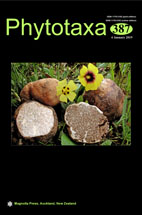Abstract
Cyanobacteria are common members of epilithic communities, contributing fixed carbon and nitrogen, providing UV light shielding pigments, helping to retain water, and in general stabilizing particles. Conversely, biofouling by cyanobacteria is of great concern in the U.S. and abroad. The epilithic growth of cyanobacteria on cultural monuments has been long noted, yet the basic systematics and diversity of these organisms is poorly understood. This paper describes two novel cyanobacteria isolated from cemetery tombstones from Jacksonville, Florida (USA). Using a total evidence approach of ecology, morphology, ITS structure, and molecular data we present two taxa new to science: Brasilonema geniculatum and Calothrix dumus. We note that tombstones represent an intriguing habitat for sampling cyanobacteria due to their ubiquity, stability, and cultural importance.

